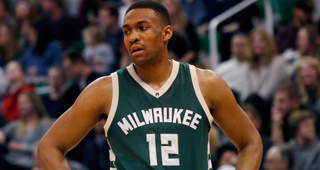In the 25th game of his rookie season, Jabari Parker grabbed a rebound and led the break down the court. He got into the paint and tried to Euro-step around his opponent to avoid a charge, planted awkwardly on his left leg and went down in a heap. All of a sudden the No. 2 overall pick in the 2014 NBA Draft was facing an uncertain future. In the following days, Parker was diagnosed with a torn ACL. For a player whose athleticism was somewhat in question leading up to being drafted, this could have been a death sentence for his career. Instead, it might have been a blessing that has led directly to his breakout season.
RealGM’s Jonny Auping wrote recently on Giannis Antetokounmpo being groomed to lead Milwaukee’s Big Three of himself, Khris Middleton and Parker. Auping mentioned Parker’s burgeoning offensive game, and that is telling part of the picture. The idea is to expand on this by offering what Parker has improved, what he can still improve upon and where his game might be headed next.
When Parker tore his ACL, he had played in and started 25 games. He was up and down, as are most rookies. There were stretches where he looked like a top tier scorer, while other games he was barely noticeable on the floor. At the time of his injury, he was finally starting to look like a consistent double figure scorer, who could score in the mid-range areas and in transition. He wouldn’t take threes, never mind making them, and his rebounding and passing were both afterthoughts as well. His defense, assumed to be a question mark entering the league, was still average at the very best. It was downright awful at the worst.
Parker made it his goal to be ready for opening night of the 15-16 season. After a reportedly aggressive rehab, he was just shy of that goal, appearing in his first game in the season’s second week. He had a bit of a slow start, which was to be expected returning from injury. The Bucks took a cautious approach and steadily built up Parker’s playing time and his role within the offense. By the second half of the season, he was scoring at a good clip, scoring under 10 points just six times in 41 games. This production has carried over to this season, with Parker averaging just a tick under 20 PPG as of this writing.
So, what changed in his game? The first thing Parker changed was his body. He came into the NBA as a somewhat doughy 6’8’’. He’s still not the most cut and defined player, but he’s stronger and quicker than he was a couple of years ago. This allows for two critical pieces of offensive improvement: getting to the line and finishing through contact. Starting midway through last season, Parker began putting the ball on the floor and going by his opponents on a regular basis. This is where his athleticism shows up. He’s too big and too strong for the average small forward to handle and he’s too quick for most power forwards. He’s a classic tweener, but in a good way. Being slightly undersized also helps him on defense, with more and more teams going small. He’s rarely overmatched inside against bigger power forwards for more than a small stretch each game.
Getting to the rim more often is made by two subtle adjustments in his game: First was tightening up his handle, especially inside the arc. When Parker came into the league, he had a high dribble and ohe would swing the ball out wide on his crossover. He was generally fine to get by his man, but as opposing players dug down to help they would regularly knock the ball away from him. Parker was able to get away with this in college and high school, as most of his opponents on that level weren’t quick enough to get to the ball. Also, players at the NCAA level don’t dig down as hard to help. Since they aren’t as quick to recover, they tend to stay closer to their own man. By keeping the ball tight with his dribble, he’s able to avoid those swiping hands and get to the basket area. He now keeps his dribble much lower and inside his shoulders.
The second adjustment Parker made was related to finishing when he gets to the basket area. This adjustment involved keeping the ball high and tight. He came into the NBA with a habit of keeping the ball at chest to waist level. This allowed opponents to strip the ball, or caused him to get his shot blocked. He now keeps the ball up around his shoulders as he drives. By eliminating the wasted time of bringing the ball up into scoring position, he reduced the amount of reaction time his opponents have to defend him. Both of these are fairly subtle changes, but both add up in a major way to make his scoring load easier. The increased strength and quickness as he’s defined his body hasn’t hurt either.
The easier to see changes are Parker’s comfort with extending his range to the arc and his rebounding. It is very early in this season, but Parker is attempting 2.6 threes per game. This is up from 0.5 from his career prior to this year. Most importantly as it pertains to this area of his game, he’s shooting almost 35% from behind the arc. Now, some of those long range attempts could dry up when Khris Middleton returns. But if you subscribe to the theory that once a player shows a skill, he owns that skill; Parker is now a true threat from distance that needs to be guarded.
He’s also rebounding at a better rate and a lot of that is directly related to him being stronger and able to hold his position better. He’s not likely to ever be a triple-double threat like Antetokounmpo, or a lockdown defender like Middleton, but Parker can hold his own on the defensive end. He’s not a negative either. And if he can score 20+ PPG, all he’ll really need to be is average as a defender to be an All-Star level player.
Middleton’s unfortunate injury might be enough to keep Milwaukee out of the playoffs this year, but that might not be the worst thing. Antetokounmpo is growing into his role as a prime playmaker and Parker is stepping up as the primary scorer. Middleton’s game is very adaptable to both of his teammates, as he’s a “3 and D” player supreme. He’s good at spotting up, and as Parker’s gravity grows, Middleton’s looks become that much cleaner.
Those three players, combined with another high draft pick and good role players, could have Milwaukee sitting pretty for the next half decade or so. Parker’s recovery from ACL surgery, improvement in his body and his game and drive to continually get better are a major part of that. And that isn’t something that looked quite as certain, even as recently as a year ago.



